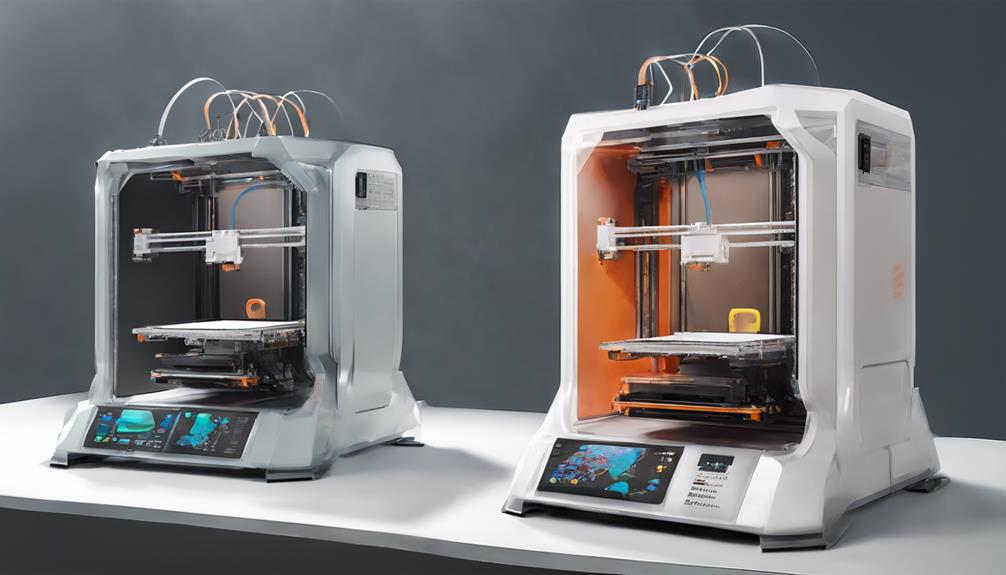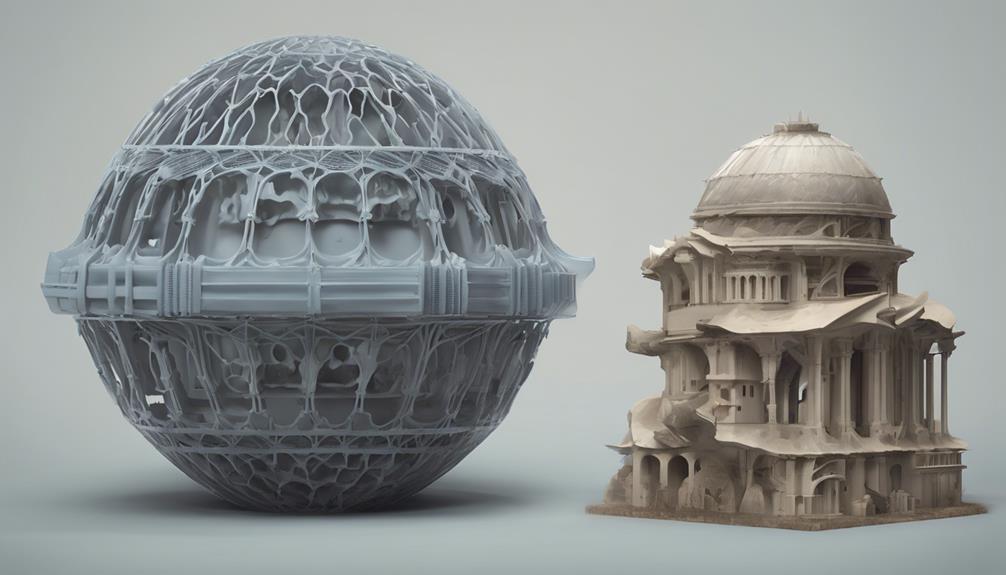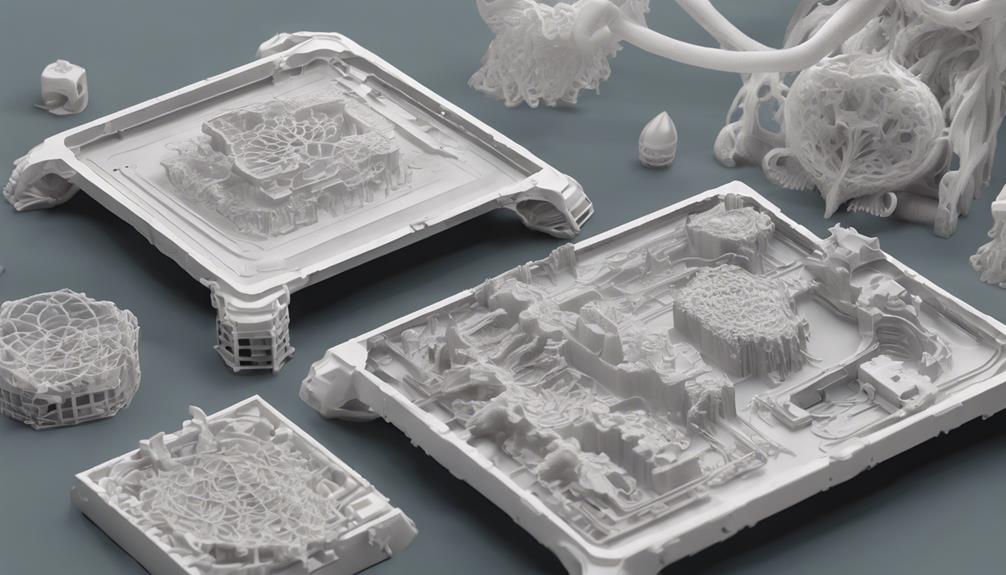When deciding between FDM and resin 3D printing methods, it's important to weigh the pros and cons for your specific requirements. FDM offers affordability and flexibility, catering to a broad range of printing needs. Conversely, resin printers shine with intricate details and superior surface finishes. But before you make your choice, consider this: the right printer can greatly impact your projects' quality and cost-effectiveness. So, which 3D printing technology will best serve your needs? The answer might surprise you.
Printer Technologies Compared

When comparing printer technologies for 3D printing, you'll find that FDM printers utilize plastic filament melted and solidified, while resin printers employ photopolymer hardened by UV light. FDM technology offers versatility, affordability, and widespread use, making it a popular choice.
On the other hand, resin printers provide high precision and a smooth surface finish, ideal for detailed models. FDM filaments are priced around $25 per KG, while resin can range from $80 to $150 per liter.
Consider your priorities – whether it's cost-effectiveness and flexibility with FDM or intricate detailing and higher costs with resin. Understanding these differences will help you make an informed decision based on your 3D printing needs.
Price Ranges and Features Overview
To understand the diverse options available in 3D printing, consider exploring the price ranges and features overview. When looking at 3D printers, you'll find a range of prices and features tailored to different needs. Here's a breakdown to help you make an informed decision:
| Price Range | Features |
|---|---|
| $200 – $300 | Entry-level DIY FDM printers, assembly required |
| $300 – $1000 | Hobbyist printers, pre-assembled, minimal calibration |
| $1000 – $3000 | Enthusiast printers, advanced features, larger build volumes |
| $3000 – $10,000 | Professional printers, high precision, reliability |
| $10,000 – $100,000 | Industrial printers, designed for industrial applications |
Recommended Features for Each Type

For hobbyist FDM printers, prioritize durability, reliability, and improved printing speed. These features will enhance your printing experience without breaking the bank.
For enthusiast printers, focus on improved print quality, speed, volume, and versatility to take your creations to the next level.
Professionals should aim for bulletproof reliability and an enhanced user interface to guarantee consistent and high-quality prints.
Industrial printers are tailored for industry-specific applications, but keep in mind the costly operation. Choose features wisely based on your needs and financial capabilities to get the most out of your 3D printing experience.
Cost Considerations and Additional Expenses
Consider the initial investment for 3D printing, encompassing printer and material costs, to make an informed decision on your budget allocation.
FDM filament typically costs around $20 for a 1Kg spool, whereas resin prices range from $15-$45 for 500ml and $28-$85 for 1 Liter. Apart from these costs, additional expenses for resin printers include protective gear and isopropyl alcohol.
While FDM printers are generally more cost-efficient regarding material expenses, resin printers have higher operating costs due to the price of resin itself. It's crucial to factor in these ongoing expenses when choosing between FDM and resin printing technologies to guarantee that your budget aligns with your printing needs.
Conclusion and Expert Recommendations

In choosing between FDM and resin 3D printing technologies, prioritize your budget and desired level of detail. Entry-level or hobbyist printers ranging from $300 to $1000 are recommended for cost efficiency and decent quality.
FDM printers are budget-friendly but may lack intricate detail, while resin printers excel in producing high-detail models but come with higher operating costs. When deciding, consider the long-term expenses associated with each technology.
Opt for FDM if you prioritize affordability and versatility, or choose resin for intricate designs and smooth finishes despite the higher material costs. Be sure to explore the recommended products section for simplified printer selection based on your specific needs and budget constraints.
Frequently Asked Questions
Can Resin Printers Use FDM Filaments for Printing?
Yes, resin printers cannot use FDM filaments for printing. Resin printers require photopolymer resin, not plastic filament, to create objects. Using the incorrect material can damage the printer and result in poor print quality.
Are There Any Safety Concerns With Resin Printing?
When using resin printers, remember safety first. Wear protective gear, handle chemicals with care, and guarantee proper ventilation. UV light exposure and resin fumes can pose risks. Prioritize precautions for a worry-free printing experience.
What Software Is Best for Slicing Models?
When slicing models, Simplify3D stands out for its versatility and customization options. It allows you to fine-tune settings for the best prints. Its user-friendly interface makes the slicing process efficient and precise, enhancing your 3D printing experience.
How Do I Maintain and Clean a Resin Printer?
To maintain and clean a resin printer, wipe the build plate with isopropyl alcohol after each print. Regularly filter and store resin properly. Clean the resin tank and build area with care to prevent contamination.
Can FDM Printers Be Upgraded to Resin Printing?
Yes, you can upgrade FDM printers to resin printing by installing a resin conversion kit. This process involves changing the print head, adding a resin vat, and adjusting the printer's settings. Verify compatibility and follow instructions carefully for successful conversion.
Conclusion
In the world of 3D printing, choosing between FDM and resin technology is like deciding between a reliable workhorse and a precision artist.
FDM printers offer affordability and versatility, while resin printers provide high precision and intricate details.
Whether you prioritize budget or quality, both options have their strengths.
So, consider your needs, weigh the pros and cons, and choose the technology that best suits your vision and goals.